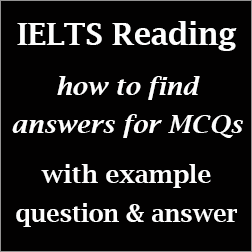This post is aimed at those AC & GT candidates who have contacted me recently for some suggestions about handling multiple choice questions in IELTS Reading exam, especially in Reading Passage 2 or 3. I hope the following strategies may come handy for those people who face problems in multiple choice questions regularly.
IELTS Reading: Step-by-step process to find answers for multiple choice questions
One of the most challenging questions to cover in IELTS Reading exam is Multiple Choice Questions, particularly when they appear in Reading Passage 2 or 3. This is because the three or four options become long and they are quite close to choosing. I personally faced this problem a lot of times, both when I practiced at home and when I appeared in the exam. Here is a step-by-step process that you can use to solve your problems with Multiple Choice Questions. To make you understand this lesson clearly, I’ve used a set of questions from Cambridge IELTS Series 9 Test 4 Reading Passage 3 entitled ‘The Development of Museums’.
Step 1:
Read each of the questions carefully and mark the KEYWORDS. If you fail to recognize the keywords, you have little chance to trace the answer. So, let’s be careful in choosing the correct keywords.
Take a look at question no. 31 of Cambridge IELTS Series 9 Test 4 Reading Passage 3 – ‘The Development of Museums’ on page 99.
- Compared with today’s museums, those of the past –
In this question, our KEYWORDS are Compared, today’s museums, past.
So, we have to find any line(s) in the passage which shows a comparison of past and present museums.
Step 2:
Go through the given three or four choices at least two times and mark the keywords in the choices which show the differences between every choice.
Here, in this question, our choices are:
a. did not present history in a detailed way.
- were not primarily intended for the public.
- were more clearly organised.
- preserved items with greater care.
Step 3:
Now, go to the passage and start skimming and try to find out words that match your KEYWORDS in the question.
Here, for this question, we should look at paragraph A as we can see a comparison made here between past and present museums.
Step 4:
Now, try to match the information found in this paragraph with the choices a, b, c or d. Here, you should read carefully, so scanning the lines will be the best thing to do.
Let’s read from paragraph A.
A. The conviction that historical relics provide infallible testimony about the past is rooted in the nineteenth and early twentieth centuries, when science was regarded as objective and value free. As one writer observes: ‘Although it is now evident that artifacts are as easily altered as chronicles, public faith in their veracity endures: a tangible relic seems ipso facto real! Such conviction was, until recently, reflected in museum displays. Museums used to look — and some still do — much like storage rooms of objects packed together in showcases: good for scholars who wanted to study the subtle differences in design, but not for the ordinary visitor, to whom it all looked alike. Similarly, the information accompanying the objects often made little sense to the lay visitor. The content and format of explanations dated back to a time when the museum was the exclusive domain of the scientific researcher.
Take a look at lines 9-10 of this paragraph, “Museums used to look — and some still do — much like storage rooms of objects packed together in showcases: good for scholars who wanted to study the subtle differences in design, but not for the ordinary visitor, to whom it all looked alike.”
The lines before these lines talk about present museums and what they store. And then, in these lines, we find what were kept in museums of the past time (Museums used to look). After that, they talk about the intended visitors (good for scholars who wanted to study the subtle differences in design, but not for the ordinary visitor, to whom it all looked alike.)
So, this information matches with choice or option (b.) were not primarily intended for the public.
So, the answer is b.
Step 5:
This is not necessary if you are sure about your choice of answer. But if you are not sure yet, you can match the lines with other choices and you will surely find some dissimilarities (the choices/option won’t match).
Special tips: Remember, this type of question follows a sequence. So, you will find the next answers in sequential order.
You should now try to find answers for questions 32-36. Hopefully, you’ll get all the answers easily.

